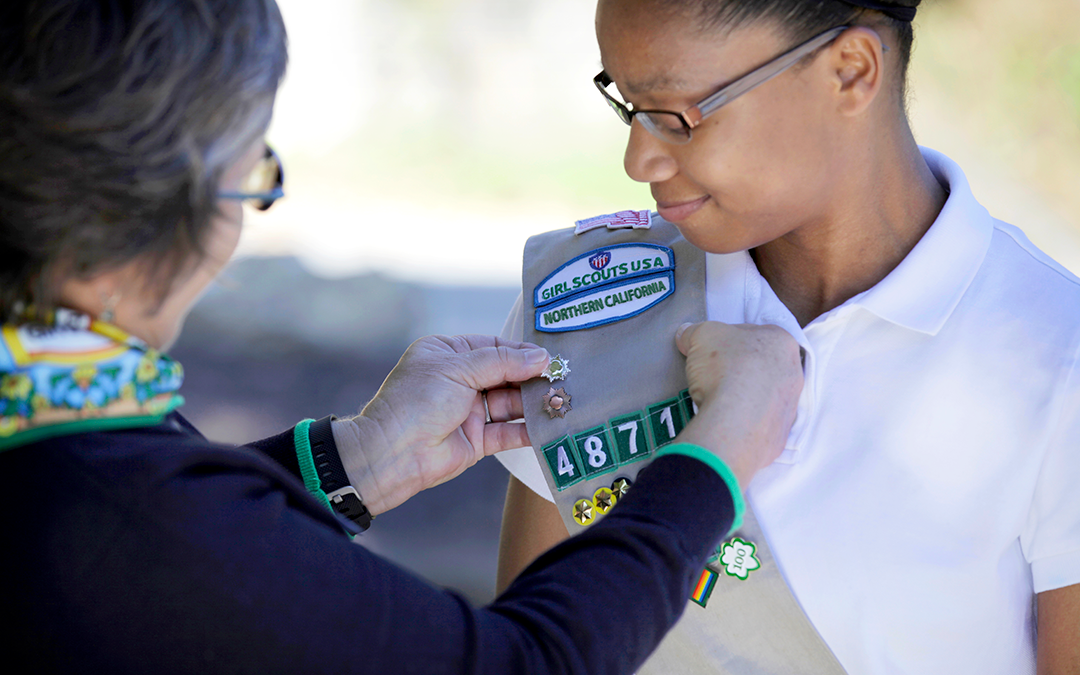The Gold Award is the highest achievement in Girl Scouting, recognizing girls who demonstrate extraordinary leadership. Their remarkable Take Action projects transform their world, solving problems sustainably in their communities—and beyond. Earning the Gold Award help girls get ahead, adding a special bonus to college applications providing a resume-builder that demonstrates problem-solving, teamwork, and leadership, and starting girls who enter the military one rank ahead.
Completing a Gold Award project may be a challenge, but understanding the process is easy with this handy guide. There are 7 steps to the process: choosing an issue, researching your future project, building a team and recruiting a project advisor to help you on your way, creating a plan, presenting it to the council, completing your project, and sharing your experience and results with the world!
Presenting your proposal to the council is a critical step toward getting your project approved so you can be on your way to being a Gold Award Girl Scout. The proposal form contains the following 8 questions:
- Describe the issue your project will address and your target audience.
- Discuss your reasons for selecting this project.
- Outline the strengths, talents, and skills you plan to put into action. What skills do you hope to develop over the course of your project?
- Briefly describe the steps involved in putting your plan into action, including any resources, facilities, equipment, and approvals needed.
- Estimate overall project expenses and how you plan to meet these costs.
- What methods or tools will you use to evaluate the impact of your project?
- How will your project be sustained beyond your involvement?
- Describe how you’ll let others know about your project, its impact, and what you learned (e.g., website, blog, presentations, posters, videos, articles).
No need to worry or feel overwhelmed! We’ve collected helpful tips and insight from committee members who have evaluated hundreds of Gold Award proposals. You’ll learn more about the process, learn how to answer each question, and turn in a successful proposal. Let’s get started on your path to Gold! Check out the Gold Award Packet in addition to the tips in this article.
Describe the issue your project will address and your target audience.
This first question is where you state the problem or issue your project will address, and explain who will benefit, as well as the underlying cause(s) of the problem, as determined by your research. Your project can focus on your own community or tackle a broader issue at the state, country, or global level. Wherever you choose — there is a community that benefits, so tell us about them, and how the issue you will address impacts them..
At minimum, you can expect the answer to this question to be six to eight sentences. Complex issues, or large-scale projects may require a longer answer to adequately address the problem, root cause, and target audience.
The Problem vs. Root Cause
Let’s talk for a moment about problem (or issue) vs. root cause. Generally speaking, a problem is easy to see. It is visible, often tangible, and right there in front of us. The root cause lies beneath the problem. Some problems have multiple contributing root causes. A root cause may be more difficult to see, understand, or address. Identifying a root cause requires some research. You will need to get out there and explore the issue, talk to people who are experts in this area, and learn from them.
For example, let’s consider the problem of homelessness. On the surface, we can all describe this problem. Put simply, there are people who do not have a stable place to call home. They may be living in their car, in shelters, or sleeping on the streets or in a park. To begin to understand the root causes of homelessness requires looking deeper at the problem and asking: Why are people homeless? The contributing root causes will vary for different groups in our community. Examples of some contributing root causes: insufficient income (not enough money), income instability (joblessness), substance dependence, or mental health challenges. Some may be fleeing domestic violence. For LGBTQ teens, the family home may no longer be a safe and welcoming place.
Whatever your topic… your Gold Award Take Action Project will address the problem and an underlying root cause.
Discuss your reasons for selecting this project.
Now that you’ve captured our attention by describing the issue and underlying root causes(s), tell us why you feel drawn to making this the focus of your Gold Award. Be personal. Why is this issue important and meaningful to you? Perhaps you’ve volunteered with this organization in the past, or want to give back to a group that has helped you. Do you have a connection to this issue through your personal experience, or that of a friend or family member? For example, a recent Gold Awardee chose to focus her Gold Award project on creating awareness, education resources, and training for EMTs who may interact with members of the Deaf community based on close friendship with a girl who is Deaf, and a recent experience she had with emergency medical professionals.
The purpose of this answer is to capture your personal connection to the topic and community you’ve chosen for your Gold Award. Answers are typically short, about four sentences. Feel free to tell us more if it adds to the Committee’s understanding of your project. Knowing your reasons for selecting a particular project or community can be valuable in our effort to support you. We often return to this information when brainstorming with you possible solutions to a roadblocks or other challenges that may pop up during your project.
Outline the strengths, talents, and skills that you plan to put into action.
It may be helpful to tackle the answer to this question in two parts—the skills you already have, and new skills you hope to develop.
First, think about the strengths you already have. Ask your friends, family, or teachers to describe what they see as your greatest strengths. Think about how those particular strengths and talents will be valuable in executing this project. Why are these skills relevant to this project in particular? For example, every project benefits from organization, but, if your project includes a team of 250 people traveling to a storm-damaged area to work on clean water projects, organization takes on a much higher level of importance!
Next, consider which skills you hope to develop as part of working on your Gold Award project. Think about what you will need to do to succeed, and what the project will demand of you. How will your project advisor and/or other subject matter experts help you develop these skills?
In both cases – for the skills you have and the skills you hope to develop – include specific examples to illustrate the connection between your project and those skills. This answer will be about four to six sentences.
Describe the steps involved in putting your project into action.
This question shows the Committee how your project will come together once it has been approved. The Committee understands that by the time you are submitting your proposal, you’ve already spent time researching the issue, developing a project plan, and reviewing that project plan with key community members. Take five to seven sentences to lay out the major sections of your plan—you don’t need to repeat yourself or go into extreme detail. Let’s consider the example of a math skill tutoring class. The major sections of this project might be: planning the curriculum, recruiting students and volunteer tutors, conducting the classes, and evaluating student improvement.
Timelines
In addition to the short summary answer, you will have to provide a timeline. The timeline is one of your key planning tools. Here you will identify the significant milestones for your project (not just “Start Project”, and “Finish Project”)—the sequence of events, key dates, and hours anticipated for those tasks. Simple projects may have a dozen or so items listed on the timeline, while complex or large-scale projects could have as many as 25 items on the timeline. You’ll use this same timeline to track the progress of your target dates, and log the actual time spent on those tasks.
Some notes about timelines:
- The minimum length requirement for a Gold Award is 80 hours. You may count up to 8 hours of your research and planning time (including writing the proposal). Time spent in a leadership role should account for at least 20% of the total project hours.
- Each task, and the time spent on it, is identified as “working” time or “leadership time.”
- Working time is the time you spend doing work for your project
- Leadership time is the time you spend coordinating and directing the work of the team you have recruited to help with your project. Leadership can include: leading a planning meeting, training volunteers, resolving conflicts, setting priorities, etc.
Although the guidance from GSUSA says the Gold Award requires a minimum of 80 hours, that number should not be your focus. The Committee rarely sees a Gold Award completed in exactly 80.00 hours. Your project will have a natural conclusion point where you have implemented the actions described in your plan, and spent some time evaluating the impact of your project. This might result in a 90 hour project or a 100 hour project. The purpose is not to create a project that takes FOR-EV-ER. The idea is to create a meaningful project of a scale and impact worthy of the Gold Award.
Pro Tip: Comparing the plan to the “as it really happened” timeline is part of the Final Report, so take good notes about your process!
Estimate overall project expenses and how you plan to meet these costs.
All Gold Award Projects need a budget. You might not actually spend any money, but you’re going to need a budget. Just like the timeline section, the budget portion of the Gold Award Project Proposal consists of two parts: a short summary blurb in the questions and answers section and a supplemental form that lists the specifics.
Put simply, your project budget is a list of all the resources you will need to implement the project—location, equipment and tools, consumable supplies (paper, signs, trash bags), food—and your plan for meeting those needs.
- What will be borrowed?
- What will be donated? What organizations will you ask for donations?
- What will need to be purchased?
- How will you raise any needed funds? Will they be troop funds or personal funds from your parents or your job?
Pro Tips: If you are planning on applying for community grants or other financial support from large corporations or community organizations, research the timeline for applying for those funds. Have a back-up plan in case the organization’s timeline does not work for your project, or if your project is not selected for funding.
If you have your eye set on a large project that requires significant funds—start early! You will need the extra time for fundraising, particularly if you are going after community grants. You will need the time to coordinate your efforts with GSNorCal’s Fund Development department, and to accommodate the grant review timeline of the sponsor organizations.
What methods or tools will you use to evaluate the impact of your project?
You will typically need three to five sentences to describe the concrete steps you will take evaluate the impact of your project. If your project includes an event that people attend, evaluating the impact is more than just “seeing that people are enjoying themselves.” You are looking for signs that your project had a positive impact on the issue and root cause discussed in the beginning of the proposal.
In many instances, a survey can be an excellent tool to evaluate impact. For an event, you might ask participants for their feedback. If your target audience is students, you might also ask their teachers, and parents for feedback. Was your project at a local park or open space preserve? Ask the Park Ranger for their feedback. If you conduct a survey, analyze the results—what conclusions can you draw from the responses? Consider also if there is there anything learned from the survey that can be passed on to the people responsible for maintaining the project in the future.
How will your project be sustained beyond your involvement?
Two things set a Gold Award Take Action Project apart from the Bronze Award or Silver Award—the focus on addressing a root cause of your chosen topic, and ensuring the sustainability of your project. Write four to six sentences about your specific efforts to help ensure that whatever you have created in your Gold Award will continue once the project is complete.
- If you are implementing a new program, who takes over next year?
- If you have a group that is taking over next year, what is their involvement this year?
- How did you identify potential volunteers or leaders who will have ownership for the project?
- What resources are you providing to help others carry it forward?
It can be useful to create a how-to guide about your project that you hand off to others. However, creating sustainability for your project is more than just leaving behind instructions and hoping someone comes along who is interested in carrying it forward. No one has a crystal ball to predict the future. We understand you can’t guarantee what will happen with your project after your involvement ends. It is your responsibility to set up your project for sustainable future success with the needed knowledge, resources, and community support.
In some cases, a Gold Award Take Action Project will have built a large-scale permanent structure as part of addressing a community need and root cause. In those few instances, it may be that the project sustainability is resolved by the installation of that structure. A few years ago, a GSNorCal Gold Award Project was completed for the San Francisco Zoo—a complete redesign and installation of a new habitat for the monkeys. Their existing habitat was falling apart and no longer meeting their needs for exercise and socialization, and the zoo staff could not care for the animals appropriately. In this case, the rebuilt habitat was itself a major part of the “sustainability” solution. In the design of the new habitat, the Gold Award project included new signs and info cards to support the zoo staff in their public education efforts about the monkeys. This education element was another part of the sustainability part of the project.
Describe how you will let others know about your project.
Social media is a big part of how we communicate and interact with the world. However, posting to Facebook, Instagram, and YouTube are mostly passive ways of talking about a Gold Award project. Using these tools, you will reach primarily people who know you and already know something about your Gold Award project. Without a dedicated effort to drive new traffic to those sites, the benefit for your project is minimal.
Rather than creating an all-new website, consider instead…
- writing an article for your school newspaper or local newspaper.
- creating a new page or blog entry (with pictures) on an existing website, such as the website for the organization benefiting from your project.
- inviting a newspaper to write an article or a news station to a broadcast a news segment or weather report from your event.
- investigating options for posting an article on your city’s website or Facebook and Twitter feeds.
- asking your partner organization(s) to post an article on their website or tweet about your event to their existing audience and followers.
The goal in telling others about your project is to reach people who otherwise might not hear about it. This should be more than your family, friends, and troop. This is your opportunity to engage the larger community in an issue that is close to your heart. It may also inspire others to get involved. Consider including a “ways you can help” section as part of your communication strategy. This might include: relevant links, phone numbers or email addresses for your partner organization, information about upcoming events by that organization, and simple actions people can implement on their own.
That’s the whole application! Here are some general tips to set you up for success as you plan and develop your proposal.
Other Items to Keep In Mind While Drafting a Gold Award Proposal
Problems that derail good ideas and delay approval as a Gold Award Project:
- No clearly defined problem or root cause
- No evidence of investigation to confirm the need for the project
- Vague answers that lack specifics (who, what, why, when, where)
- Poorly edited proposals with repeated grammar or spelling errors
- Run-on sentences that confuse your message
Ask your reviewer to identify, based only on the application…
- Who is the target audience? (This might include age range, number of people, community segment, demographic, etc.)
- What are you doing? (Describe what exactly your project will entail.)
- Why is this project needed? (What need/problem is addressed, and why it is not addressed by other means?)
- When does this take place? (This can be general like Spring semester, sor next summer, or specific like exact dates.)
- Where does this take place? (Is it at a specific school, park, clinic, organization…)
Pro tip: Give your completed project proposal to someone who does not know your project. Ask them to read it and give feedback. Consider asking more than one person to be a reviewer. You might ask one person to be your editor—looking at grammar, spelling, and structure—while another reviewer focuses on content, checking if you have complete, robust answers with specifics and clear connections between the answers for related questions. Your reviewers should be from outside your family and troop.
Paperwork pointers:
- For our Juliette Girl Scouts: The requirement for leader signature should be completed by volunteers from your service unit. This may be the Gold Award coordinator or other leadership position.
- For girls whose parent is also the troop leader: Your parent may not sign off (as troop leader). There is a spot for parent sign-off, but that’s a separate requirement. For Troop Leader approval you can ask a co-leader, the troop’s Gold Award coordinator (if you have one), or another Service Unit volunteer.
- A note about Project Advisors and parents… A parent should not be a primary subject matter expert for your project. Let your parents be parents: a cheering section, your sounding board, and providers of encouragement and snacks for those research and work sessions. Find someone else in the community to be your Project Advisor. This person is also your primary subject matter expert. Often this is a staff member at your partner organization. If you are creating a project for a school, it will be a teacher or administrator. For a project at a hospital or clinic you will likely have a nurse, doctor or clinician as your advisor.
The committee can’t wait to read all the incredible Gold Award proposals we’ll get this next year—hopefully one of them will be yours!
What to do next:
- Check out the pre-reqs for starting your Gold Award, and review the Proposal form.
- Explore the Gold Award in detail with these resources, or attend a webinar!
- Get inspired by this years’ National Gold Award Girl Scout from our GSNorCal council!
- Looking for more resources to level-up your older girl Girl Scouting experience? Check out these Trailhead posts.
 Michele Harms—Michele is a long-time member of the South Bay Gold Award Committee. She is a lifetime Girl Scout, now in her 41st consecutive year. As an adult volunteer, Michele has always worked in Older Girl programs. During college, Michele was a mentor for a Cadette troop in San Luis Obispo. She estimates that she has reviewed over 1500 Gold Award proposals – navigating 3-4 cycles of changes to the program requirements. Michele earned her Gold and Silver Awards with Girl Scouts of Orange County. Outside of Girl Scouts, Michele is a devoted aunt, avid traveler, and Quality Assurance Engineer.
Michele Harms—Michele is a long-time member of the South Bay Gold Award Committee. She is a lifetime Girl Scout, now in her 41st consecutive year. As an adult volunteer, Michele has always worked in Older Girl programs. During college, Michele was a mentor for a Cadette troop in San Luis Obispo. She estimates that she has reviewed over 1500 Gold Award proposals – navigating 3-4 cycles of changes to the program requirements. Michele earned her Gold and Silver Awards with Girl Scouts of Orange County. Outside of Girl Scouts, Michele is a devoted aunt, avid traveler, and Quality Assurance Engineer.
 Allison Wright—Allison is a South Bay Gold Award Committee member. She is in her 28th year as a Girl Scout (13 years as a girl, 15 years as an adult). Allison grew up as a Girl Scout in the San Diego council. While at Iowa State University she was a Junior and Cadette Troop Leader in GS of Greater Iowa; a special interest troop leader and the chair for the council-wide Gold Award committee for GS of Kansas Heartland. Allison is passionate about Girl Scouts; she has continued to volunteer with the program since earning her Gold Award in 2002. Outside of Girl Scouts, Allison is an Aerospace Engineer working in Nondestructive Inspection of Composite Aircraft.
Allison Wright—Allison is a South Bay Gold Award Committee member. She is in her 28th year as a Girl Scout (13 years as a girl, 15 years as an adult). Allison grew up as a Girl Scout in the San Diego council. While at Iowa State University she was a Junior and Cadette Troop Leader in GS of Greater Iowa; a special interest troop leader and the chair for the council-wide Gold Award committee for GS of Kansas Heartland. Allison is passionate about Girl Scouts; she has continued to volunteer with the program since earning her Gold Award in 2002. Outside of Girl Scouts, Allison is an Aerospace Engineer working in Nondestructive Inspection of Composite Aircraft.


